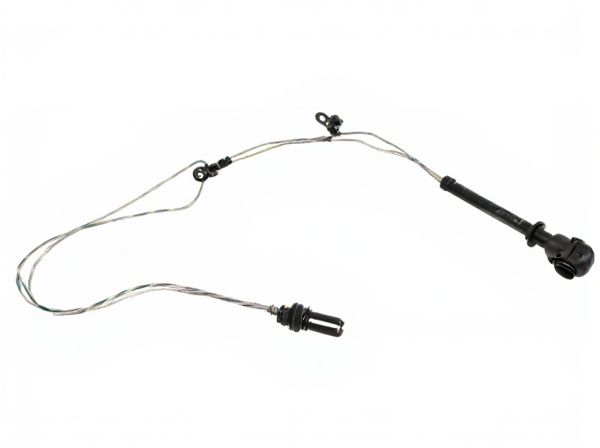
Photo illustration: Steer-by-Wire vs Column-Mounted Steering
Steer-by-wire technology offers precise control and enhanced safety by eliminating the mechanical connection between the steering wheel and wheels, allowing for adaptive feedback and customizable steering responses. Column-mounted steering provides a traditional tactile feel with direct mechanical linkage, offering consistent feedback but less flexibility in tuning steering dynamics. Your choice depends on whether you prioritize cutting-edge innovation with customizable performance or tried-and-true mechanical reliability.
Table of Comparison
| Feature | Steer-by-Wire | Column-Mounted Steering |
|---|---|---|
| Steering Mechanism | Electronic signals control steering angle, no mechanical link | Mechanical linkage connects steering wheel to wheels |
| Response Time | Instant electronic response | Mechanical delay present |
| Steering Feel | Customizable feedback via actuators | Direct mechanical feedback |
| Safety | Redundant electronic systems for fail-safe operation | Mechanical robustness, limited redundancy |
| Maintenance | Lower mechanical wear, software updates required | Regular mechanical inspections and repairs |
| Weight | Reduced weight due to fewer mechanical parts | Heavier due to mechanical components |
| Space Efficiency | Flexible dashboard design, saves space | Requires fixed steering column space |
| Cost | Higher initial cost, potential long-term savings | Lower upfront cost, higher maintenance expenses |
| Reliability | Dependent on electrical system integrity | Proven mechanical reliability |
| Application | Advanced EVs, autonomous vehicles | Traditional vehicles, mass-market cars |
Introduction to Modern Steering Technologies
Steer-by-wire technology replaces traditional mechanical linkages with electronic controls, enhancing precision and allowing customizable steering responses tailored to driver preferences. Column-mounted steering systems rely on a mechanical connection between the steering wheel and the vehicle's wheels, offering familiar feedback but limiting advanced integration with autonomous driving features. Modern steering innovations prioritize improved safety, reduced weight, and enhanced driving dynamics through seamless electronic integration and adaptive control systems.
Overview: Steer-by-Wire Explained
Steer-by-Wire replaces traditional mechanical linkages with electronic controls, enhancing precision and reducing vehicle weight. This system transmits driver inputs via electronic signals to actuators, eliminating the physical connection between the steering wheel and wheels. Benefits include improved steering response, customizable feedback, and easier integration with advanced driver-assistance systems (ADAS).
Understanding Column-Mounted Steering Systems
Column-mounted steering systems utilize a mechanical linkage connecting the steering wheel directly to the steering mechanism, providing tactile feedback and a traditional driving experience. These systems rely on shafts, universal joints, and gears to transmit driver input, ensuring precise control and reliability in various driving conditions. Compared to Steer-by-Wire technology, column-mounted steering maintains a direct physical connection, enhancing driver awareness but lacking the electronic flexibility and weight savings offered by wire-based systems.
Key Differences Between Steer-by-Wire and Column-Mounted Steering
Steer-by-wire systems replace the traditional mechanical connection between the steering wheel and wheels with electronic controls, enhancing precision and reducing mechanical complexity. Column-mounted steering relies on a physical shaft linking the steering wheel to the steering mechanism, providing direct tactile feedback but limited flexibility in design and integration. Key differences include responsiveness, system weight, customization options, and maintenance requirements, with steer-by-wire offering advanced driver assistance system integration and improved energy efficiency.
Performance and Responsiveness Comparison
Steer-by-Wire systems deliver superior performance and responsiveness by eliminating the mechanical linkage between the steering wheel and wheels, allowing precise control through electronic signals that reduce latency and enhance vehicle handling. Column-mounted steering relies on physical connections, which can introduce slight delays and mechanical play, affecting steering precision and feedback during dynamic driving. High-performance vehicles benefit from Steer-by-Wire's ability to customize steering response and improve agility, while traditional column-mounted systems offer familiar tactile feedback but with less adaptability and reduced responsiveness.
Safety Features and Reliability
Steer-by-wire systems eliminate mechanical connections between the steering wheel and wheels, enhancing safety by reducing the risk of component failure and allowing instant adjustment during emergencies. Column-mounted steering relies on physical linkages vulnerable to wear, impacting long-term reliability and increasing maintenance needs. Advanced fail-safe mechanisms and electronic redundancy in steer-by-wire improve dependable steering control, marking a significant advancement over traditional column-mounted steering for modern automotive safety.
Impact on Vehicle Design and Interior Space
Steer-by-wire technology eliminates the mechanical link between the steering wheel and the wheels, enabling flexible placement of steering controls and optimizing cabin layout for enhanced interior space. Column-mounted steering requires a physical steering column, limiting design freedom and intruding into legroom and dashboard areas. Adopting steer-by-wire facilitates innovative vehicle architectures and improved ergonomics by freeing designers from traditional constraints imposed by column-mounted systems.
Maintenance and Longevity Considerations
Steer-by-wire systems eliminate mechanical linkages, reducing wear and tear and lowering maintenance frequency compared to traditional column-mounted steering, which requires regular inspection of physical components like steering columns and shafts. Electronic components in steer-by-wire demand periodic software updates and sensor checks but generally offer longer operational life due to fewer mechanical failures. In contrast, column-mounted steering can suffer from mechanical degradation over time, impacting longevity and increasing repair costs.
Future Trends in Automotive Steering Technology
Steer-by-wire technology eliminates mechanical linkages, enabling more precise and customizable steering responses compared to traditional column-mounted steering systems. Future trends indicate integration of advanced sensors, AI-driven control algorithms, and enhanced haptic feedback to improve safety and driving experience. Continued development in wireless steering is expected to facilitate autonomous vehicle functionality and reduce vehicle weight for improved efficiency.
Choosing the Right Steering System: Factors to Consider
Choosing between Steer-by-Wire and Column-Mounted Steering systems depends on factors such as vehicle type, desired driving precision, and safety features. Steer-by-Wire offers enhanced responsiveness and customizable steering feedback, ideal for electric and autonomous vehicles. Column-Mounted Steering provides familiar mechanical feedback and simplicity, making it suitable for traditional and budget-friendly models.
 caratoz.com
caratoz.com